Gregory A. Fournier's Blog, page 23
October 31, 2017
WEMU "Hidden In Plain Sight" Broadcast--John Norman Collins
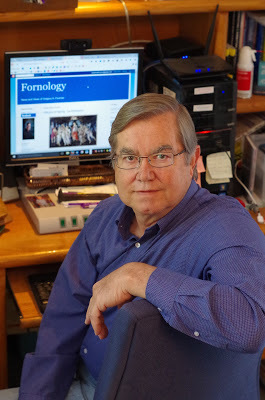 Photo taken by Nicole Fribourg.On October 18th, 2017, WEMU in Ypsilanti, Michigan asked me to record my observations while touring some of the landmarks of John Norman Collins's serial killing spree in Washtenaw County in the late 1960s. One link takes you to the internet article, the other takes you to the audio.
Photo taken by Nicole Fribourg.On October 18th, 2017, WEMU in Ypsilanti, Michigan asked me to record my observations while touring some of the landmarks of John Norman Collins's serial killing spree in Washtenaw County in the late 1960s. One link takes you to the internet article, the other takes you to the audio.My remarks are based on my true crime book Terror In Ypsilanti: John Norman Collins Unmasked, available in a paperback edition, all ebook formats, and an audiobook at http://www.amazon.com/Gregory-A.-Fournier/e/B00BDNEG1C
Link to the WEMU article: http://wemu.org/post/hidden-plain-sight-terror-ypsilanti#stream/0
Link to MP3 audio: https://cpa.ds.npr.org/wemu/audio/2017/10/terror_in_ypsi.mp3
Published on October 31, 2017 05:41
October 25, 2017
WEMU to Air Terror In Ypsilanti Audio Tour

Last week, Eastern Michigan University's NPR radio station in Ypsilanti serving Washtenaw County recorded my observations on several sites important to the John Norman Collins killing spree of 1967-1969. WEMU will air an eight-minute feature on Monday, October 30th. If you can't listen to the program when it airs, I'll run a link on this blog and route it on my social media outlets.
 Patrick CampionProgram Director Patrick Campion and I stopped at the boarding house where Collins lived and sexually harassed a number of young women; then, we went to the wig shop where Karen Sue Beineman was last seen alive getting onto the back of Collins's stolen Triumph motorcycle; next, we stopped outside the David Leik house where Collins tortured and killed Miss Beineman in the basement; and finally, we drove to the gully in Ann Arbor where Miss Beineman's body was dumped.
Patrick CampionProgram Director Patrick Campion and I stopped at the boarding house where Collins lived and sexually harassed a number of young women; then, we went to the wig shop where Karen Sue Beineman was last seen alive getting onto the back of Collins's stolen Triumph motorcycle; next, we stopped outside the David Leik house where Collins tortured and killed Miss Beineman in the basement; and finally, we drove to the gully in Ann Arbor where Miss Beineman's body was dumped.Special thanks to Lisa Powers--University of Michigan Office of Student Publications--for taking photographs of this outing.
***
 2017 has been a great year for Terror In Ypsilanti: John Norman Collins Unmasked (TIY). In addition to winning an International Book Award and a Literary Classics Silver Award, TIY just won an Independent Author Network finalist award. I'd like to thank my loyal readers for their support, especially those who wrote Amazon book reviews.
2017 has been a great year for Terror In Ypsilanti: John Norman Collins Unmasked (TIY). In addition to winning an International Book Award and a Literary Classics Silver Award, TIY just won an Independent Author Network finalist award. I'd like to thank my loyal readers for their support, especially those who wrote Amazon book reviews.http://www.amazon.com/Gregory-A.-Fournier/e/B00BDNEG1C
Published on October 25, 2017 10:12
September 21, 2017
Criminalistic Junk Science
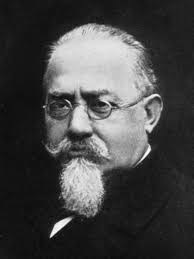 Cesare LombrosoIn the late nineteenth-century, Italian psychiatrist Cesare Lombroso advanced the idea of the "born criminal" based loosely on the work of naturalist Charles Darwin. Lombroso believed the criminal could be distinguished by "abnormalities" in the skull, face, and body. He compiled a list of criminal traits including receding hairline, forehead wrinkles, bumpy face, broad noses, fleshy lips, sloping shoulders, elongated arms, and pointed fingers.
Cesare LombrosoIn the late nineteenth-century, Italian psychiatrist Cesare Lombroso advanced the idea of the "born criminal" based loosely on the work of naturalist Charles Darwin. Lombroso believed the criminal could be distinguished by "abnormalities" in the skull, face, and body. He compiled a list of criminal traits including receding hairline, forehead wrinkles, bumpy face, broad noses, fleshy lips, sloping shoulders, elongated arms, and pointed fingers.In the Gilded Age of Queen Victoria, the belief there was a "face of evil" was an easy one in the era of Jack the Ripper. In the first half of the twentieth-century, this theory was strongly reinforced in American popular culture through radio mysteries, crime cinema, dime novels, and pulp-fiction detective magazines. This folklore reinforced the idea that criminals are easily identified because they look different from other people--loosely defined as "us".
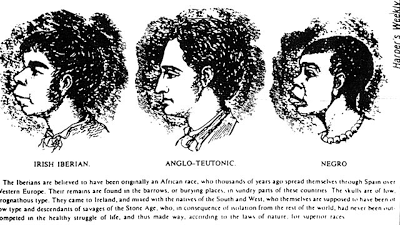
Rather than scientific, these ideas broke along racial and ethnic lines. In nineteenth-century America, religion was also considered a prejudicial factor in determining guilt. It was generally believed by Anglo-Saxon Protestants--who made up the social and power elite--that Catholic and Jewish immigrants bore a greater responsibility for crime in cities like Boston and New York than law-abiding American folk. In Germany, the Nazis made great use of the pseudo-science of Social Darwinism against European Jews, which they documented in the last century.
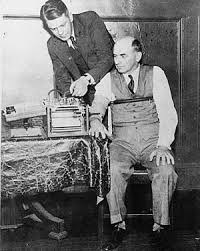 In the early twentieth century, two new forms of pseudoscience gained popularity in law enforcement circles, the polygraph test--also known as a "lie detector" test--and the intravenous injection of truth serum. The polygraph machine measures and records several physiological indices such as blood pressure, pulse, respiration, and skin conductivity. The belief is that deceptive answers will record a different response that true responses.
In the early twentieth century, two new forms of pseudoscience gained popularity in law enforcement circles, the polygraph test--also known as a "lie detector" test--and the intravenous injection of truth serum. The polygraph machine measures and records several physiological indices such as blood pressure, pulse, respiration, and skin conductivity. The belief is that deceptive answers will record a different response that true responses. Sodium pentothal was invented in 1934 intended to be a pain killer, but it was found to relax subjects who would answer questions put to them in an unguarded and uninhibited fashion while under the influence of the sedative. During World War II, the drug was widely used as an anti-anxiety drug by psychiatrists for battle fatigue.
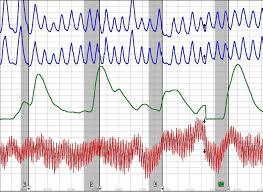 Polygraph printout.Polygraph tests measure arousal and are inherently subjective. They can be affected by anxiety disorders and other factors. In 2002, the National Research Council noted "There is no specific physiological reaction associated with lying. The mechanisms associated with lying are unknown making it difficult to identify factors that separate liars from truth tellers." The National Academy of Sciences stated that polygraph tests "are simply unreliable, unscientific, biased, and inadmissible in the United States court system."
Polygraph printout.Polygraph tests measure arousal and are inherently subjective. They can be affected by anxiety disorders and other factors. In 2002, the National Research Council noted "There is no specific physiological reaction associated with lying. The mechanisms associated with lying are unknown making it difficult to identify factors that separate liars from truth tellers." The National Academy of Sciences stated that polygraph tests "are simply unreliable, unscientific, biased, and inadmissible in the United States court system."The belief that lie detectors are a useful forensic tool is generally discredited, but the myth is keep alive in the popular culture through fiction and film. Polygraph tests today are the subject of comedy as in Meet the Parents 3 where Robert De Niro straps a vintage polygraph machine to Ben Stiller for comic effect.
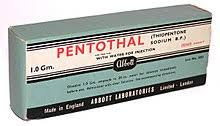 The idea of truth serum also has been the mainstay of pulp-fiction and true crime magazines. Its conceptual originator was Dr. Robert House in 1915. He gave the drug scopolamine to women during childbirth and noticed that they would speak spontaneously and respond to any questions put to them while under the influence.
The idea of truth serum also has been the mainstay of pulp-fiction and true crime magazines. Its conceptual originator was Dr. Robert House in 1915. He gave the drug scopolamine to women during childbirth and noticed that they would speak spontaneously and respond to any questions put to them while under the influence. Sodium pentothal was invented in 1934 by Ernest H. Volwiler and Donalie L. Tabern as a sedative or painkiller, but it soon became what the public regarded as truth serum. Side effects included short-term memory loss, headache, nausea, agitation, drowsiness, and up to a three day hangover.
 In 1963, the United States Supreme Court ruled that "barbiturate confessions" produced under the influence of truth serum were unconstitutionally coerced and therefore inadmissible. Truth serum results are not accepted by Western legal systems and legal experts as genuine investigative tools.
In 1963, the United States Supreme Court ruled that "barbiturate confessions" produced under the influence of truth serum were unconstitutionally coerced and therefore inadmissible. Truth serum results are not accepted by Western legal systems and legal experts as genuine investigative tools.There is no drug proven to cause consistent or predictable enhancement of truth-telling. Studies have found that subjects questioned under the influence of truth serum are suggestible and their memories are subject to reconstruction and fabrication. Another problem is what the subject perceives as truth cannot be differentiated from unbiased, factual truth.
Unlike fingerprint and DNA science, Social Darwinism, polygraph tests, and truth serum are considered junk science and have no place in modern investigative forensics.
Published on September 21, 2017 08:47
September 13, 2017
Ypsilanti's Historic Depot Town
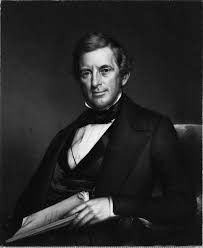 Mark Norris (1796-1862)Ypsilanti, Michigan was a ramshackle frontier town on the old Chicago Road in 1828 when pioneer Mark Norris and his family settled just east of the Huron River. Perhaps more than any other Ypsilanti citizen, Norris advanced the development of the city. He was an industrious and shrewd businessman. He owned a wool carding company, a dry goods store, the Western Hotel next to the railroad, the Norris Block building on River Street, and the Ypsilanti Flour Mill.
Mark Norris (1796-1862)Ypsilanti, Michigan was a ramshackle frontier town on the old Chicago Road in 1828 when pioneer Mark Norris and his family settled just east of the Huron River. Perhaps more than any other Ypsilanti citizen, Norris advanced the development of the city. He was an industrious and shrewd businessman. He owned a wool carding company, a dry goods store, the Western Hotel next to the railroad, the Norris Block building on River Street, and the Ypsilanti Flour Mill.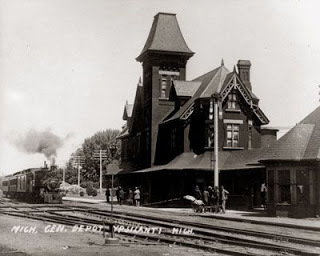 Original Ypsilanti DepotIt was Mark Norris who convinced the Michigan Central Railroad to make Ypsilanti a scheduled stop and construct a wooden loading dock and a freight warehouse giving birth to Depot Town. The first train arrived on February 2, 1838. Ypsilanti was no longer an isolated frontier town. It became an economic hub for the area's growing agricultural and manufacturing concerns. In 1864, the railroad built a lovely, three-story train depot said to be the nicest between Detroit and Chicago. Unfortunately, the upper floors were destroyed by fire in 1910--only the ground floor was rebuilt.
Original Ypsilanti DepotIt was Mark Norris who convinced the Michigan Central Railroad to make Ypsilanti a scheduled stop and construct a wooden loading dock and a freight warehouse giving birth to Depot Town. The first train arrived on February 2, 1838. Ypsilanti was no longer an isolated frontier town. It became an economic hub for the area's growing agricultural and manufacturing concerns. In 1864, the railroad built a lovely, three-story train depot said to be the nicest between Detroit and Chicago. Unfortunately, the upper floors were destroyed by fire in 1910--only the ground floor was rebuilt.Depot Town became a staging area for the Underground Railroad from 1841 until the 1860s. Escaped slaves hid in safe houses or wherever they could during the day and traveled down the Huron River at night. During the Civil War, the 14th Michigan Infantry Regiment and the 27th Michigan Infantry Regiment shipped out from Depot Town heading for the South.
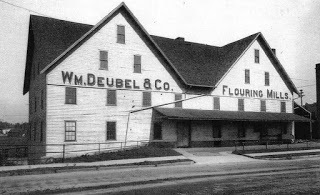 Cross Street Bridge is left--Depot Town is right.A thriving two-block-long commercial district grew up along both sides of East Cross Street. Mark Norris built his flour mill on the northeast corner of Cross Street next to the Huron River sometime in the 1850s. A water canal raceway powered the waterwheel. The property changed hands several times. In 1874, William Deubel bought the mill and ran it with his sons. The mill was damaged by fire in 1915 and rebuilt. It became obsolete in the electrical age and was demolished in 1925.
Cross Street Bridge is left--Depot Town is right.A thriving two-block-long commercial district grew up along both sides of East Cross Street. Mark Norris built his flour mill on the northeast corner of Cross Street next to the Huron River sometime in the 1850s. A water canal raceway powered the waterwheel. The property changed hands several times. In 1874, William Deubel bought the mill and ran it with his sons. The mill was damaged by fire in 1915 and rebuilt. It became obsolete in the electrical age and was demolished in 1925.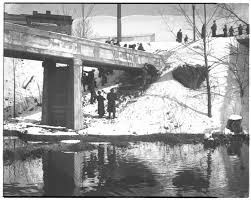 Frog Island Bridge--March 8, 1935.The old flour mill was gone, but the water raceway remained. During the Depression, the Works Progress Administration (WPA) built a footbridge north off the Cross Street Bridge over the raceway leading to Frog Island Park. The following year on March 8th, 1935, the body of seven-year-old Richard Streicher, Jr. was found stabbed and frozen to death beneath the footbridge.
Frog Island Bridge--March 8, 1935.The old flour mill was gone, but the water raceway remained. During the Depression, the Works Progress Administration (WPA) built a footbridge north off the Cross Street Bridge over the raceway leading to Frog Island Park. The following year on March 8th, 1935, the body of seven-year-old Richard Streicher, Jr. was found stabbed and frozen to death beneath the footbridge.Richard Streicher, Jr. post:
https://fornology.blogspot.com/2016/11/little-richard-streicher-ypsilantis.html
Published on September 13, 2017 14:50
September 4, 2017
Unexpected America: A Memoir by Wanjiru Warama
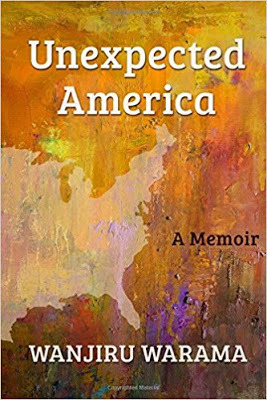 At the age of six, Wanjiru Warama [WAHN-jee-row Wa-RAH-Ma] had no knowledge of the world outside the Rift Valley in the East African British colony of Kenya. Her father was from the Kikuyu tribe, the largest ethnic group in the country and loyal to the British. He worked for a wealthy farm owner but only made enough money for his family to live in abject poverty.
At the age of six, Wanjiru Warama [WAHN-jee-row Wa-RAH-Ma] had no knowledge of the world outside the Rift Valley in the East African British colony of Kenya. Her father was from the Kikuyu tribe, the largest ethnic group in the country and loyal to the British. He worked for a wealthy farm owner but only made enough money for his family to live in abject poverty. After World War II, it became increasingly difficult for European countries to maintain a colonial presence in Africa. Kenya was given its independence from the United Kingdom in 1963 after eight years of guerrilla warfare known as the Mau Mau Uprising from 1952 through 1960. Amidst this political and civil strife, Wanjiru was sent to Nairobi where she was fortunate enough to be enrolled in a school where she earned a high school diploma.
Realizing education and job training were her only avenues for social mobility and personal independence, Wanjiru was motivated to pursue a business degree from United States International University (USIU) in Naiorbi. Reasoning that opportunities were scarce in the capital city of Nairobi and wanting to expand her horizon, Wanjiru saved up enough money from her clerical job to finance the final year of her bachelor degree program and transfer to the USIU San Diego campus.
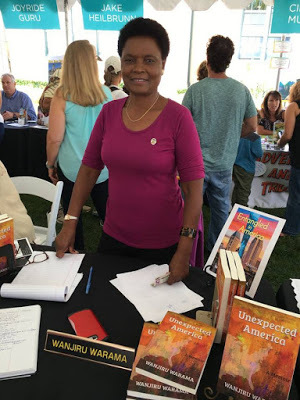 San Diego Festival of books--August 2017.This is where Wanjiru Warama's memoir Unexpected America begins. Armed with a certified check made out to USIU for a year's expenses, a student visa, and a plane ticket, Wanjiru arrives to make her stake on the American Dream only to discover a culture shock beyond her imagination. Her naive view of America collides squarely with the harsh realities of being an immigrant, a minority, and a woman in America--compounded by being in one of the most competitive job markets in the United States, San Diego, California.
San Diego Festival of books--August 2017.This is where Wanjiru Warama's memoir Unexpected America begins. Armed with a certified check made out to USIU for a year's expenses, a student visa, and a plane ticket, Wanjiru arrives to make her stake on the American Dream only to discover a culture shock beyond her imagination. Her naive view of America collides squarely with the harsh realities of being an immigrant, a minority, and a woman in America--compounded by being in one of the most competitive job markets in the United States, San Diego, California.Told in straightforward prose with revealing candor, Wanjiru weaves her story of determination, hard work, and perseverance in the face of seemingly insurmountable odds to establish herself as an American citizen. May her story be an inspiration to others who come to this country seeking a better life for themselves and their families.
Amazon link: https://www.amazon.com/Unexpected-America-Wanjiru-Warama/dp/0998051306/ref=sr_1_1?s=books&ie=UTF8&qid=1504469409&sr=1-1&keywords=Unexpected+America
Published on September 04, 2017 08:30
August 23, 2017
Winding Down Terror In Ypsilanti
 My wife and I at Detroit Bookfest 2017.Since Terror In Ypsilanti: John Norman Collins Unmasked was published last August, it has done well in the marketplace for an independently published book. This project took me, with the help of my researcher Ryan M. Place, five years to gather and research public documents, interview people connected with the case, and write the book; almost a year to edit the manuscript and publish it; and a solid year to promote the title and arrange author talks and book signings. It's been a busy year.
My wife and I at Detroit Bookfest 2017.Since Terror In Ypsilanti: John Norman Collins Unmasked was published last August, it has done well in the marketplace for an independently published book. This project took me, with the help of my researcher Ryan M. Place, five years to gather and research public documents, interview people connected with the case, and write the book; almost a year to edit the manuscript and publish it; and a solid year to promote the title and arrange author talks and book signings. It's been a busy year.Over the last seven years, I have made nineteen round-trip flights from San Diego to Detroit to bring the tragic facts of these fifty-year-old serial murders to the forefront. Six of the seven murders never went to trial, so those facts were largely unknown to the public.
Writing TIY has met or surpassed all of my original goals. I set out to:
recognize and pay respect to the memories of John Norman Collins's victims, their identities obfuscated by the use of pseudonyms in an earlier novelized account,clarify the facts and circumstances surrounding these murders obscured by time and misinformation on the Internet,reconstitute a faithful rendition of the Collins case which was purged from the files of the Washtenaw County Court sometime in 1976,and counter the blatant lies, alibis, and prevarications of Collins's attempts from prison to manipulate the press and the public. These falsehoods were given new life by social media.The positive book reviews on Amazon and Goodreads are appreciated more than I can say, but occasionally I receive an email or letter of a personal nature which helps validate the long and difficult task it took to cobble this tragic story together.
The latest letter I received was from Michaeline B. after my July tour in Michigan. She gave me permission to run an edited version of her remarks. Being able to move people with words may be the most satisfying thing I have accomplished with my writing. On this note, I end my 2017 promotions and move forward to my next project.
"It was a pleasure meeting you. I have finished Terror In Ypsilanti. My testament to your writing skills can best be told this way: I am an avid reader who almost never reads hard copy books. Ebooks suit my reading style and needs better. Yet, I read Terror in record time, adjusting my reading prerequisites accordingly without complaint. I even lugged this paperback around during the Traverse City Film Festival to better use my waiting-in-line time.
This is not a feel good book in any usual sense as the story is awful and sad. However, as one who is disturbed by the shortcomings--even the failures of our (criminal) justice system--you make a very satisfying case for justice decently served. I appreciate that.
The late sixties found me preoccupied with early motherhood duties and the big public events of the period (Vietnam, civil rights, the moon walk, etc.). Overwhelming! To a large extent, John Norman Collins and the related horror barely made it onto my radar screen. In some unspoken and unrecognized sense, I chastised myself over the years for my neglect. Thanks to you, I have done my duty to be informed on this matter--finally.
Devoting five years to this endeavor is a high price to pay, Greg. Please accept my humble thanks, admiration, and congratulations.... I look forward to reading Zug Island: A Detroit Riot Novel."
I thank Michaeline for sharing her story with me, and I appreciate every book review readers write on Amazon and Goodreads. It is these word-of-mouth endorsements that make the best kind of promotion and warm this author's heart.
Published on August 23, 2017 14:18
August 5, 2017
Detroit Bookfest 2017 Surpasses Expectations
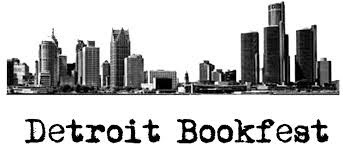
Organized as a "goodwill effort to help generate a deeper love and appreciation of books in the Greater Detroit community," the Bookclub of Detroit sponsored Bookfest 2017 was a rousing success for the city and festival organizers. Held in Shed 5 at the historic Eastern Market on Detroit's eastside, people from every corner of the city and the surrounding suburbs came out in force. The foot traffic was strong all day. Thousands of people attended.
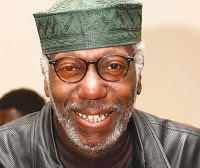 Author Herb BoydIn adition to rare and used books, contemporary works and their authors were present as exhibitors, most notably Herb Boyd, the author of recently published Black Detroit: A People's History of Self-Determination. I was happy to meet Herb and get his autograph on my copy. Michigan independent author Claudia Whitsitt and yours truly shared a table and did quite well at the end of the day.
Author Herb BoydIn adition to rare and used books, contemporary works and their authors were present as exhibitors, most notably Herb Boyd, the author of recently published Black Detroit: A People's History of Self-Determination. I was happy to meet Herb and get his autograph on my copy. Michigan independent author Claudia Whitsitt and yours truly shared a table and did quite well at the end of the day. 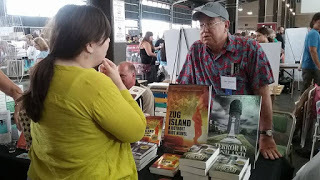 Making a sale.Books were not the only attraction. Vendors included food trucks, craft beer, photography, vintage LP vinyl, movie memorabilia, local craft items, clothing, and more. The festival was a free, family friendly event and a good time was had by all.
Making a sale.Books were not the only attraction. Vendors included food trucks, craft beer, photography, vintage LP vinyl, movie memorabilia, local craft items, clothing, and more. The festival was a free, family friendly event and a good time was had by all.While talking with Janet Jones, owner of Source Booksellers in Midtown Detroit, I commented on how Bookfest appeared to be a big hit. Her response was, "That it happened at all was good for the city." I agree with Janet and I will be back next year for Bookfest II.
Congratulations to Ryan M. Place and his team for organizing such a well-run and well-received event. In addition to the Bookclub of Detroit, other Bookfest sponsors were the City of Detroit, Eastern Market, Margrave Pictures, Cafe D'Mongo's, John K. King Used Books, White Raven Books, Black Lotus Brewing Co., and DJ Zig-Zag.
For more information on Detroit's Eastern Market:
https://www.easternmarket.com/
Published on August 05, 2017 13:11
Detroit Bookfest 2017 Supasses Expectations

Organized as a "goodwill effort to help generate a deeper love and appreciation of books in the Greater Detroit community," the Bookclub of Detroit sponsored Bookfest 2017 was a rousing success for the city and festival organizers. Held in Shed 5 at the historic Eastern Market on Detroit's eastside, people from every corner of the city and the surrounding suburbs came out in force. The foot traffic was strong all day. Thousands of people attended.
 Author Herb BoydIn adition to rare and used books, contemporary works and their authors were present as exhibitors, most notably Herb Boyd, the author of recently published Black Detroit: A People's History of Self-Determination. I was happy to meet Herb and get his autograph on my copy. Michigan independent author Claudia Whitsitt and yours truly shared a table and did quite well at the end of the day.
Author Herb BoydIn adition to rare and used books, contemporary works and their authors were present as exhibitors, most notably Herb Boyd, the author of recently published Black Detroit: A People's History of Self-Determination. I was happy to meet Herb and get his autograph on my copy. Michigan independent author Claudia Whitsitt and yours truly shared a table and did quite well at the end of the day.  Making a sale.Books were not the only attraction. Vendors included food trucks, craft beer, photography, vintage LP vinyl, movie memorabilia, local craft items, clothing, and more. The festival was a free, family friendly event and a good time was had by all.
Making a sale.Books were not the only attraction. Vendors included food trucks, craft beer, photography, vintage LP vinyl, movie memorabilia, local craft items, clothing, and more. The festival was a free, family friendly event and a good time was had by all.While talking with Janet Jones, owner of Source Booksellers in Midtown Detroit, I commented on how Bookfest appeared to be a big hit. Her response was, "That it happened at all was good for the city." I agree with Janet and I will be back next year for Bookfest II.
Congratulations to Ryan M. Place and his team for organizing such a well-run and well-received event. In addition to the Bookclub of Detroit, other Bookfest sponsors were the City of Detroit, Eastern Market, Margrave Pictures, Cafe D'Mongo's, John K. King Used Books, White Raven Books, Black Lotus Brewing Co., and DJ Zig-Zag.
For more information on Detroit's Eastern Market:
https://www.easternmarket.com/
Published on August 05, 2017 13:11
Detroit Bookfest 2017 Suppasses Expectations

Organized as a "goodwill effort to help generate a deeper love and appreciation of books in the Greater Detroit community," the Bookclub of Detroit sponsored Bookfest 2017 was a rousing success for the city and festival organizers. Held in Shed 5 at the historic Eastern Market on Detroit's eastside, people from every corner of the city and the surrounding suburbs came out in force. The foot traffic was strong all day. Thousands of people attended.
 Author Herb BoydIn adition to rare and used books, contemporary works and their authors were present as exhibitors, most notably Herb Boyd, the author of recently published Black Detroit: A People's History of Self-Determination. I was happy to meet Herb and get his autograph on my copy. Michigan independent author Claudia Whitsitt and yours truly shared a table and did quite well at the end of the day.
Author Herb BoydIn adition to rare and used books, contemporary works and their authors were present as exhibitors, most notably Herb Boyd, the author of recently published Black Detroit: A People's History of Self-Determination. I was happy to meet Herb and get his autograph on my copy. Michigan independent author Claudia Whitsitt and yours truly shared a table and did quite well at the end of the day.  Making a sale.Books were not the only attraction. Vendors included food trucks, craft beer, photography, vintage LP vinyl, movie memorabilia, local craft items, clothing, and more. The festival was a free, family friendly event and a good time was had by all.
Making a sale.Books were not the only attraction. Vendors included food trucks, craft beer, photography, vintage LP vinyl, movie memorabilia, local craft items, clothing, and more. The festival was a free, family friendly event and a good time was had by all.While talking with Janet Jones, owner of Source Booksellers in Midtown Detroit, I commented on how Bookfest appeared to be a big hit. Her response was, "That it happened at all was good for the city." I agree with Janet and I will be back next year for Bookfest II.
Congratulations to Ryan M. Place and his team for organizing such a well-run and well-received event. In addition to the Bookclub of Detroit, other Bookfest sponsors were the City of Detroit, Eastern Market, Margrave Pictures, Cafe D'Mongo's, John K. King Used Books, White Raven Books, Black Lotus Brewing Co., and DJ Zig-Zag.
For more information on Detroit's Eastern Market:
https://www.easternmarket.com/
Published on August 05, 2017 13:11
July 30, 2017
Willow Run Bomber Plant Changes Ypsilanti Forever
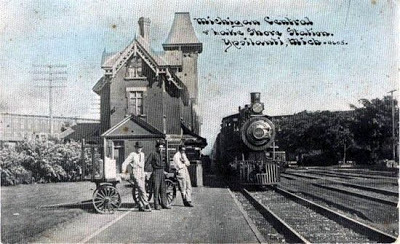 Original Three-story Ypsilanti Depot Station.At the turn of the century, before the second World War, Ypsilanti had an active downtown area along Michigan Avenue. Northeast of town, there was a thriving business district called Depot Town.
Original Three-story Ypsilanti Depot Station.At the turn of the century, before the second World War, Ypsilanti had an active downtown area along Michigan Avenue. Northeast of town, there was a thriving business district called Depot Town.Depot Town was the area's commercial hub and provided services for weary train travelers. Ypsilanti's three-story brick depot station was ornate compared to the depot in Ann Arbor. In its day, it was said to be the nicest train station between Detroit and Chicago.
The Norris Building built in 1861 was across from the depot on River Street. It was originally supposed to house a retail block on the ground floor and residential rooms on the two upper floors. Instead, the building became an army barracks during the Civil War. The 14th Michigan Infantry Regiment shipped out of Depot Town in 1862, as did the 27th Michigan Regiment in 1863.
The facade of the historic Norris Building remains on North River Street, despite a fire which decimated the rear portion of this last remaining Civil War barracks in Michigan. Work has begun on rebuilding the historic building.
Michigan State Normal School was located west of Depot Town on West Cross Street and northwest of downtown Ypsilanti. It spawned a growing educational center which later expanded its mission to become Eastern Michigan University.
Ypsilanti's residential area with its historic and varied architecture filled the spaces between. Surrounding everything was some of the most fertile farm land in the state.
The water-powered age of nineteenth century manufacturing on the Huron River gave way to the modern electrical age of the twentieth century. The soft beauty of the gas light to illuminate homes was replaced with the harsh glare of the incandescent light bulb. The times were changing for Ypsilanti--ready or not.
***
The countryside was prime tillable ground with fruit groves scattered about the countyside. Henry Ford owned a large tract of land in an area known as Willow Run, named for the small river that ran through it. The Ford patriarch used the land to plant soybeans, but the United States government needed bombers for the Lend Lease program with Great Britain. On December 8, 1941, one day after the Japanese bombed Pearl Harbor, the Nazis declared war on the United States on behalf of their ally. America was drawn into the second world war.
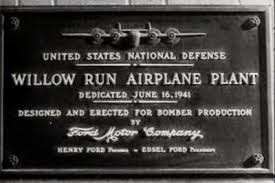 The Roosevelt administration asked the Ford corporation, now run by Edsel Ford, to build a factory that could mass produce the B-24 Liberator Bomber. Edsel Ford, Charles Sorenson (production manager), and some Ford engineers visited the Consolidated Aircraft Company in San Diego to see how the planes were built.
The Roosevelt administration asked the Ford corporation, now run by Edsel Ford, to build a factory that could mass produce the B-24 Liberator Bomber. Edsel Ford, Charles Sorenson (production manager), and some Ford engineers visited the Consolidated Aircraft Company in San Diego to see how the planes were built. That night, Sorenson drew up a floor plan that could build the bomber more efficiently. His blueprint was a marvel of ingenuity, but the Ford corporation made one significant change in his master plan.
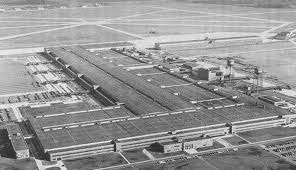 The best shape to build a front to back assembly line operation is in a straight line. But to avoid the higher taxes in Democratic Wayne County, the bomber plant took a hard right to the south on one end to stay within Republican Washtenaw County, which had lower taxes. This was at the insistance of Harry Bennett, Ford's head of security who had strong ties to Washtenaw County being a graduate of Ann Arbor High School.
The best shape to build a front to back assembly line operation is in a straight line. But to avoid the higher taxes in Democratic Wayne County, the bomber plant took a hard right to the south on one end to stay within Republican Washtenaw County, which had lower taxes. This was at the insistance of Harry Bennett, Ford's head of security who had strong ties to Washtenaw County being a graduate of Ann Arbor High School. The construction of the plant in Willow Run began in May of 1941, seven months before Pearl Harbor. Lengendary Detroit architect Albert Kahn designed the largest factory in the world, but it would be his last project. He died in 1942.
The federal government bought up land adjacent to the bomber plant and built an airport which still exists today and is used for commercial aviation. The eight-sectioned hangar could house twenty Liberators.
***Soon, workers flooded into Ypsilanti and the rapidly developing Willow Run area where makeshift row housing was hastily constructed. Overnight, the sleepy farming and college town of Ypsilanti became a three shift, 24/7, blue collar community.
Suddenly the area was hit with a housing shortage. Ypsilanti homeowners rented rooms to workers or converted their large Victorian homes into boarding houses. It was wartime and money was to be made. Some families rented "warm beds." One worker would sleep in the bed while another was working his shift, but still there was a housing shortage. Many people slept in their cars until they could make other arrangements.
Ford sent recruiters to Kentucky and Tennessee to draw workers in from the south. That is when the derisive term "Ypsitucky" originated. Long time residents did not like the changes they saw in their town. The bomber factory workers worked hard and drank hard. Fights broke out in local bars, and Ypsilanti developed a hard edge and a dark reputation.
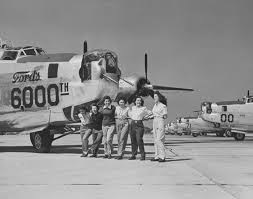 Because so many men were in uniform serving their country, there was a shortage of skilled labor at first. But then the women of Southern Michigan stepped up big time. They donned work clothes, and tied up their long hair in colorful scarves. It was calculated at the end of the war that 40% of every B-24 Liberator was assembled by women.
Because so many men were in uniform serving their country, there was a shortage of skilled labor at first. But then the women of Southern Michigan stepped up big time. They donned work clothes, and tied up their long hair in colorful scarves. It was calculated at the end of the war that 40% of every B-24 Liberator was assembled by women.***
Little known factoid: The first stretch of expressway in America was made with Ford steel and Ford cement. It connected workers in the Detroit area to their jobs at the bomber plant in Willow Run via Ecorse Road. It's still there and runs along the north end of the former GM Hydromatic Plant and Willow Run Airport.
***
The Yankee Air Museum housed on the east end of Willow Run Airport was established in 1981 to restore and preserve the almost forgotten history of Willow Run Airport, and to commemorate the achievement of the men and women who helped win the war by the sweat of their brow producing 8,685 B-24 Liberators.
Background history of the Yankee Air Museum: http://yankeeairmuseum.org/our-history/
The following link has some vintage bomber plant footage: http://www.annarbor.com/news/ypsilanti/pbs-to-air-documentary-about-ypsilantis-legendary-willow-run-b-24-bomber-factory/
Published on July 30, 2017 04:28



